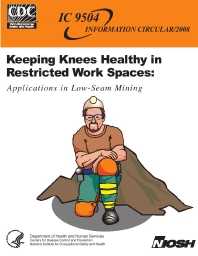Mining Product: Keeping Knees Healthy in Restricted Work Spaces: Applications in Low-Seam Mining
Original creation date: May 2008
This training package educates the mining community about some possible interventions beyond kneepads that may be used to help decrease knee injury rates.
Many challenges are faced by workers in lower-seam (42 inches or less) mines. The lower-seam heights confine mine workers to their knees as they perform their daily tasks such as installing roof bolts, delivering supplies, repairing belt, or cutting coal. Miners often consider kneepads to be their only line of defense against knee injuries. However, other interventions such as changing postures, proper hygiene, and work station design can also reduce the risk of developing knee injuries. Incorporating these and many other interventions into a mine worker's "way of life" is an important step to ensuring a long, healthy career and retirement. Keeping knees healthy is also a key aspect to reducing costs in low-seam mines as the industry battles rising health care costs, and training/recruitment of replacement workers is time-consuming and costly.
 This training package is a downloadable ZIP file containing the following items
This training package is a downloadable ZIP file containing the following items
- An Instructor's Guide that explains how to use all of these items.
- "Information Circular 9504 - Keeping Knees Healthy in Restricted Work Spaces: Applications in Low-Seam Mining" (an overview of how this training was developed, including a glossary of terms)
- Six (8.5" x 11") bulletins to be posted in mine facilities
- Two (2' x 2') posters to be posted in mine facilities
- Two types of reflective stickers to be distributed to mine workers
- Four (8.5" x 11") safety talks to be given to mine workers preshift
- One bifold flyer to be given to the mine workers
- Three training modules, which may be given individually or combined int one presentation
Installation notes:
- Download and extract the ZIP file (NIOSH/USBM Numbered Publication) below to a folder on your hard disk.
- Start by opening the files called "READ Me.txt" and "Instructor's Guide.pdf" in the root directory.
Authors: SM Moore, LJ Steiner, MT Nelson, AG Mayton, KG Fitzgerald, JP Hubert
Audience: Mine trainers and health and safety professionals
NIOSH/USBM Numbered Publication - May 2008
NIOSHTIC2 Number: 20034189
Pittsburgh, PA: U.S. Department of Health and Human Services, Public Health Service, Centers for Disease Control and Prevention, National Institute for Occupational Safety and Health, DHHS (NIOSH) Publication No. 2008-130, 2008, May; :1-16
See Also
- Characteristics of Gait in Restricted Vertical Space Versus Unrestricted Walking
- Demands on the Knee During Kneeling and Squatting Activities Common to Low-seam Mining
- Forces and Moments on the Knee During Kneeling and Squatting
- Inaccuracy of Area Sampling for Measuring the Dust Exposure of Mining Machine Operators in Coal Mines
- Overview of U.S. Research on Three Approaches to Ensuring That Coal Miners Work Safely: Management, Workplace Design and Training
- Pressure Distribution on the Anatomic Landmarks of the Knee and the Effect of Kneepads
- Pressures Applied to Anatomical Landmarks of the Knee While in Kneeling Postures
- Research Report on Refuge Alternatives for Underground Coal Mines
- Technology for Remote Mine Seal Construction
- Technology News 535 - NIOSH Releases New Educational Video: Escape from Farmington No. 9: An Oral History
- Update on Refuge Alternatives: Research, Recommendations, and Underground Deployment
- Page last reviewed: 9/26/2017
- Page last updated: 9/4/2014
- Content source: National Institute for Occupational Safety and Health, Mining Program


 ShareCompartir
ShareCompartir
